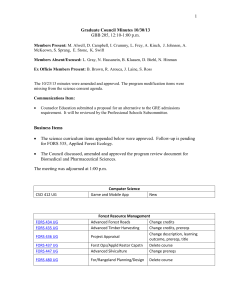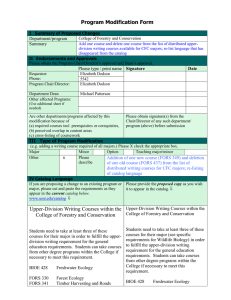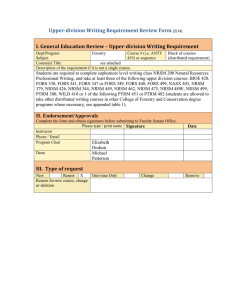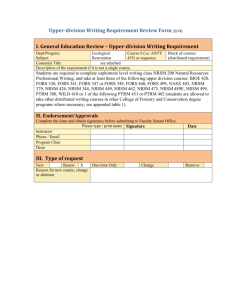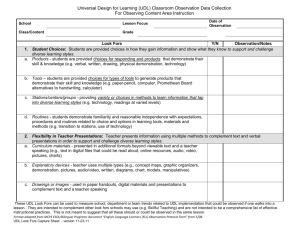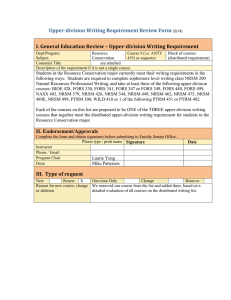College of Forestry and Conservation (CFC) Academic Year 2014-2015 Assessment Report
advertisement
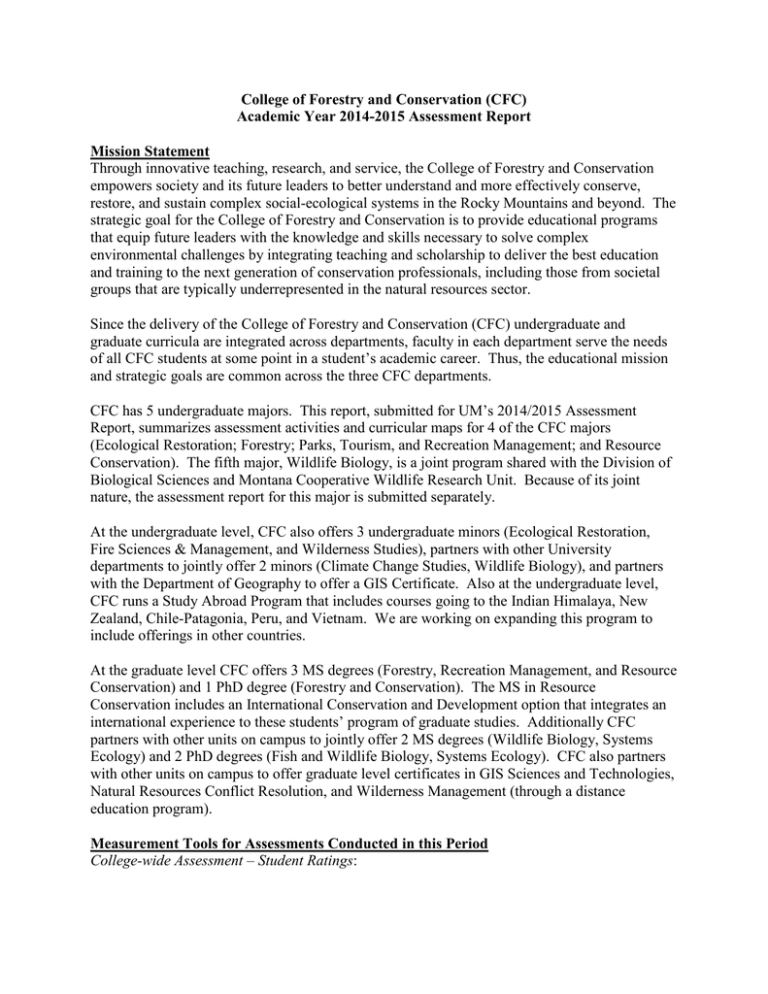
College of Forestry and Conservation (CFC) Academic Year 2014-2015 Assessment Report Mission Statement Through innovative teaching, research, and service, the College of Forestry and Conservation empowers society and its future leaders to better understand and more effectively conserve, restore, and sustain complex social-ecological systems in the Rocky Mountains and beyond. The strategic goal for the College of Forestry and Conservation is to provide educational programs that equip future leaders with the knowledge and skills necessary to solve complex environmental challenges by integrating teaching and scholarship to deliver the best education and training to the next generation of conservation professionals, including those from societal groups that are typically underrepresented in the natural resources sector. Since the delivery of the College of Forestry and Conservation (CFC) undergraduate and graduate curricula are integrated across departments, faculty in each department serve the needs of all CFC students at some point in a student’s academic career. Thus, the educational mission and strategic goals are common across the three CFC departments. CFC has 5 undergraduate majors. This report, submitted for UM’s 2014/2015 Assessment Report, summarizes assessment activities and curricular maps for 4 of the CFC majors (Ecological Restoration; Forestry; Parks, Tourism, and Recreation Management; and Resource Conservation). The fifth major, Wildlife Biology, is a joint program shared with the Division of Biological Sciences and Montana Cooperative Wildlife Research Unit. Because of its joint nature, the assessment report for this major is submitted separately. At the undergraduate level, CFC also offers 3 undergraduate minors (Ecological Restoration, Fire Sciences & Management, and Wilderness Studies), partners with other University departments to jointly offer 2 minors (Climate Change Studies, Wildlife Biology), and partners with the Department of Geography to offer a GIS Certificate. Also at the undergraduate level, CFC runs a Study Abroad Program that includes courses going to the Indian Himalaya, New Zealand, Chile-Patagonia, Peru, and Vietnam. We are working on expanding this program to include offerings in other countries. At the graduate level CFC offers 3 MS degrees (Forestry, Recreation Management, and Resource Conservation) and 1 PhD degree (Forestry and Conservation). The MS in Resource Conservation includes an International Conservation and Development option that integrates an international experience to these students’ program of graduate studies. Additionally CFC partners with other units on campus to jointly offer 2 MS degrees (Wildlife Biology, Systems Ecology) and 2 PhD degrees (Fish and Wildlife Biology, Systems Ecology). CFC also partners with other units on campus to offer graduate level certificates in GIS Sciences and Technologies, Natural Resources Conflict Resolution, and Wilderness Management (through a distance education program). Measurement Tools for Assessments Conducted in this Period College-wide Assessment – Student Ratings: One of the assessment changes the College of Forestry and Conservation has made since the last program assessment report is a shift to using the student course evaluations as one means of assessing and monitoring quality instruction. Historically CFC used the student course evaluations only as part of the CBA mandated faculty evaluation process. However, last year we started compiling data on ratings for “course as a whole” and “instructor effectiveness” as one basis for assessing and monitoring across time the quality of our teaching at a programmatic level. Under this process, each semester, we analyze/report the percent of courses for which 70% or more of the students rate the course/instructor effectiveness as Excellent/Very Good. We also identify the percentage of courses in which 30% or more of the students rate the course/instructor as Fair/Poor/Very Poor. Separately we chart the actual distribution of ratings in each class for all courses with a given prefix on a single page to allow a more detailed analysis of how ratings are distributed in specific courses (this summary is not included in this report because it is traceable back to specific faculty). These data are then reviewed by the Department Chairs who decide whether the information warrants follow-up action. Additionally, all majors in CFC encourage, and some require, employment as part of the undergraduate curricula. Since the last assessment, CFC has conducted surveys of our seniors (to examine employment experience while a student) and of a sample of our alumni (last year, 5 years out, and 10 years out) to examine post-graduation placement. Forestry Major Assessment – Upper Division Writing Assessment Grading rubric scores for written assignments were collected for one of the distributed upperdivision writing courses in Spring 2014. The rubric is based on a 5-point scale (with 5 representing the highest score). Resource Conservation Major Assessment – Upper Division Writing Assessment Resource Conservation faculty are working on assessment measures for a subset of the distributed upper-division writing courses (e.g. FORS 330, NRSM 422, NRSM 379, NRSM 475, NRSM 489). Assessment measures will be drawn from final/core papers or analyses in 4-5 senior-level courses. These assessment measures will be implemented in 2015. Resource Conservation students will also complete exit surveys beginning in 2015. Results and Modifications College-wide Assessment – Student Ratings: The results of this analysis are summarized in Appendix 1. The data were informative in identifying issues we should address with respect to provision of our curriculum. A pattern that was immediately apparent is that classes taught by TA’s and adjuncts typically received lower ratings than those taught by our permanent faculty. As a result we have increased our early semester communication with TA’s and adjuncts and the Associate Dean reaches out to make sure these individuals know he is available to address issues that arise. We intend to expand these outreach efforts further. Additionally, the report to the Department Chairs flags specific courses that might need special attention. Department Chairs have used this information to help decide whether to continue with specific adjuncts. For those on-going instructors who have low positive ratings (i.e. substantially below the 70% excellent/very good) and/or high negative ratings (at or above the > 30% fair/poor/very poor) we have asked the Chairs to look into the situation to consider whether the instructors are addressing the situation and to consider if additional mentoring is necessary. Treating the teaching evaluations in this way has been informative and helped us change our practice. We intend to continue to track teaching evaluations in the manner illustrated in the Appendix 1 tables, to expand our pre-semester outreach to TA’s and adjuncts, and to more proactively look for opportunities to have TA’s “apprentice” with established faculty in the semester before they teach a class. We also will continue to encourage Chairs to review this information each semester and, when appropriate, to meet with faculty about the evaluations in preparation for offerings of the course in subsequent semesters. Surveys regarding employment of our students before and after graduation indicated this dimension of our program is highly effective. By the time they are seniors in their last semester, 95% of our students have held a job or internship related to their major, 80% of these are paid positions, and these positions were with 160 different employers. The survey of alumni indicates that 97% of our graduates are employed or in graduate school, 85% of those employed are in fields related to the major they studied in. While some of the jobs for recent graduates are seasonal, these seasonal jobs appear to lead to full time employment – 10 years after graduation, 82% of CFC alumni were working full-time in their field of study. Although these data indicate good success with respect to linking students to employment opportunities, CFC has worked to enhance our efforts to support students in this area. Working with Career and Internship Services we have developed a stronger job search feature on our website (see http://www.cfc.umt.edu/resources/job-search.php) which students can use to seek internships, seasonal jobs and permanent jobs. This database is actively managed and kept up-to-date. Additionally, we have created an interactive Goolge-map (see http://www.cfc.umt.edu/resources/jobs.php) which allows prospective and current students to see where our students are getting the internship and summer jobs that meet our curricular work requirements. Forestry Major Assessment These data will serve as a baseline to help assess the writing preparation and skill development within the Forestry Major. The Table below reports the average scores on the 5-point scale for each evaluation element. Writing assignments shown are in chronological order. (Note: Students are allowed rewrites on these assignments.) Assignment Field Lab 1/27/14 Field Lab 2/10/14 Model Yarder Lab Slash Lab Road Introduction Lab Ashby Creek Lab Quality of WritingOrganization 4.53 4.93 4.95 4.62 Grammar and Punctuation 4.00 3.83 4.79 4.60 Content Accurate 5.00 4.88 5.00 4.81 Content Complete 3.64 4.51 4.40 3.31 5.00 4.68 4.81 4.93 5.00 5.00 4.53 4.37 APPENDIX 1: CFC Student Ratings By Course Prefix Fall 2013 Reported are questions 1 and 4 from the student evaluation sheets. Subsequent pages contain detailed tabulations [not included in this report since this data are traceable back to individual faculty]. Q1 Course as a whole rating as a whole: Faculty taught classes > 70% Excellent/Very Good ratings TA/Adj taught classes > 70% Excellent/Very Good ratings FORS 12/21,2 83% 0% NRSM 16/11,3 25% 0% PTRM 7/11 100% 0% WILD 7/11 100% 50% WRIT 3/01 0% - Faculty taught classes > 30% Fair/Poor/Very Poor ratings 0% 19% 0% 0% 0% TA/Adj taught classes> 30% Fair/Poor/Very Poor ratings 100% 100% 0% 0% 1 # of Faculty taught classes/# of TA/Adj Taught Classes (note: for this report “faculty” includes all permanent tenure-line and nontenure-line positions, adjuncts includes only temporary hires) 2 Note: FORS 391 had 2 instructors and is rated twice, FORS 538 had 2 instructors, each rated separately 3 Note: ENSC 245 included with NRSM, had 3 instructors, each rated separately) Q4 Instructor Effectiveness: Faculty taught classes > 70% Excellent/Very Good ratings TA/Adj taught classes > 70% Excellent/Very Good ratings Faculty taught classes > 30% Fair/Poor/Very Poor ratings TA/Adj taught classes> 30% Fair/Poor/Very Poor ratings Same footnotes as above Average Response Rates: Faculty – course as a whole TA/Adj – course as a whole Faculty – instructor effectiveness TA/Adj – instructor effectiveness FORS 12/21,2 92% 0% NRSM 16/11,3 50% 0% PTRM 7/11 100% 0% WILD 7/11 100% 50% WRIT 3/01 100% - 0% 100% 19% 100% 0% 0% 0% 0% 0% - FORS 57% 67% NRSM 76% 60% PTRM 85% 83% WILD 67% 75% WRIT 70% - 56% 67% 75% 60% 85% 83% 62% 71% 70% - Observations: • Overall, ratings suggest well-received curricula and effective teachers • Classes taught by TA’s and adjuncts typically are rated lower than those taught by faculty (3 courses that had > 40% Fair/Poor/Very Poor ratings were identified). • NRSM prefixes as a whole do rank lower in the proportion of students giving highest ratings when data is split using the above cutoffs. Of the faculty taught classes: o [identifier removed] seems to warrant attention (~60% Fair/Poor/Very Poor ratings) o [identifier removed], offered in its current mode for the first time, also appears to warrant attention (in 2 sections 40% rated it as Fair/Poor/Very Poor and 1 section ~30% did so) • There is nearly a 30% difference in average Student Response rate by major (high = PTRM @85%, low FORS @57%) Spring 2014 Reported are questions 1 and 4 from the student evaluation sheets. Subsequent pages contain detailed tabulations [not included in this report since this data are traceable back to individual faculty]. Q1 Course as a whole rating as a whole: Faculty taught classes > 70% Excellent/Very Good ratings TA/Adj taught classes > 70% Excellent/Very Good ratings FORS 16/21,2 63% 0% NRSM 11/41 64% 0% PTRM 4/31 50% 33% WILD 6/31 83% 66% WRIT 3/31 0% 33% Faculty taught classes > 30% Fair/Poor/Very Poor ratings 6% 9% 0% 17% 0% TA/Adj taught classes> 30% Fair/Poor/Very Poor ratings 0% 0% 0% 0% 33% 1 # of Faculty taught classes/# of TA/Adj Taught Classes (note: for this report “faculty” includes all permanent tenure-line and nontenure-line positions, adjuncts includes only temporary hires) 2 Note: FORS 330 had 2 TA instructors and is rated twice. Q4 Instructor Effectiveness: Faculty taught classes > 70% Excellent/Very Good ratings TA/Adj taught classes > 70% Excellent/Very Good ratings Faculty taught classes > 30% Fair/Poor/Very Poor ratings TA/Adj taught classes> 30% Fair/Poor/Very Poor ratings Same footnotes as above Average Response Rates: Faculty – course as a whole TA/Adj – course as a whole Faculty – instructor effectiveness TA/Adj – instructor effectiveness FORS 12/21,2 69% 0% NRSM 11/41 55% 0% PTRM 4/31 75% 66% WILD 6/31 83% 66% WRIT 3/31 33% 67% 0% 50% 0% 25% 0% 33% 0% 0% 0% 33% FORS 57% 61% NRSM 83% 51% PTRM 63% 67% WILD 90% 72% WRIT 67% 78% 57% 60% 81% 51% 62% 67% 89% 72% 67% 78% Observations: • Overall ratings suggest well received courses & effective teachers. But compared to Fall 2013 overall course quality ratings trend somewhat lower in all prefixes except NRSM (which had only 25% in the Excellent/Very Good category in Fall). • Classes taught by TA’s and adjuncts again are typically rated lower than those taught by faculty especially with respect to instructor effectiveness. o 50% of respondents rated a section of [identifier removed] Fair/Poor/Very Poor on teaching effectiveness (but this same individual taught the most highly rated section of [identifier removed] (~88% Excellent/Very good rating on effectiveness) o > 40% of respondents in [identifier removed] rated teaching effectiveness Fair/Poor/Very Poor – since this individual who has been scheduled to teach both semesters this year, some attention here seems warranted. o > 35% of respondents in [identifier removed] rated teaching effectiveness Fair/Poor/Very Poor – since that individual is being considered again, this might warrant attention. • Of the faculty taught classes: o > 40% of respondents rated [identifier removed] Fair/Poor/Very Poor o ~35% of respondents rated [identifier removed] Fair/Poor/Very Poor o ~29% of respondents rated [identifier removed] Fair/Poor/Very Poor APPENDIX 2: CURRICULM MAPS B.S. in Ecological Restoration Degree Learning Outcomes 1. Demonstrate a thorough understanding of the natural science and ecosystem management foundations of ecological restoration. 2. Demonstrate knowledge of the human dimensions of restoration practice. 3. Critically analyze scientific theories and ecosystem management practices and integrate concepts within these two fields. 4. Demonstrate proficiency in field methods, data collection, and data management, and basic knowledge of statistics and sampling design. 5. Develop and apply written and oral communication skills to restoration science and practice. 6. Develop and implement an independent project that contributes to either the field of restoration ecology or to restoration efforts. Key to Curriculum Map (see following page): “I”= introduced; “D” = developed/reinforced, with opportunities to practice; “M” = mastery that is demonstrated; and “A”=assessment evidence is collected. Lower case letters indicate that letter only applies if certain courses are selected. Course Rubric & # CORE BIOB 160N BIOB 260 BIOB 272 BIOE 370 CHMY 121N CHMY 123N COMX111A; or THTR 120A FORS 201; WILD 240; or STAT 216 NRSM 121S, 170, or 180 NRSM 265 NRSM 365 NRSM 385 NRSM 422 NRSM 444 NRSM 449E or 489E NRSM 494 NRSM 495 WRIT 101 WRIT 325; or NRSM 200 Social Elective AQUATIC OPTION BIOE 428 GEO 101N/102N M 171 M 172 AQ Electives TERRESTRIAL OPTION BIOO 105N BIOO 335 FORS 330 or 360; or BIOE 447 or 448 M 162 NRSM 210 TERR Electives Course Title Principles of Living Systems Cell & Molecular Biology Genetics & Evolution General Ecology General Chemistry Organic & Bio Chem Public Speaking; or Intro to Acting Forest Biometrics; Intro to Biostats; or Statistics Nature of Montana; International Env. Change; or Careers in Natural Resources Elem of Ecol Restoration Restoration Ecology Watershed Hydrology Natural Resource Policy Ecological Restoration Capstone Climate Change Ethics or Ethics Forestry and Conservation Seminar in Ecol Rest Ecological Restoration Practicum College Writing Science Writing; or Natural Resources Professional Writing Students select from list 1 Intended Learning Outcomes 2 3 4 5 I I I I, D I I I, D I I I I, D M I M, A M, A M, A I I I, D I, D M, A I I, D M I M, A M, A M, A M, A I D D I I, D M, A I, D M, A M, A M, A M M I D D, M M, A D Freshwater Ecology Intro to Physical Geology Calc 1 Calc 2 Students select from list I, D I I I M D, m I I I I d, m Botany Rocky Mtn Flora Forest Ecology; Range Ecology; Terr. Ecosys. Ecology; or Terr. Plant Ecology I I, D I, D D D D D, m I I d, m Applied Calculus Soils, water, climate Students select from list 6 I I M M, A m, a M, A M, A B.S. in Forestry Degree Learning Outcomes 1. Incorporate biological, social, and physical science, ecological principles and processes into the analysis of natural resource issues 2. Conduct and integrate both quantitative and qualitative analyses to critically analyze natural resource management problems 3. Develop written and oral communication skills to be successful in a professional environment 4. Formulate implementable plans at a range of scales that incorporate multiple resource values Key to Curriculum Map "I"=Introduced; "D"= developed/reinforced, with opportunities to practice; "M"=mastery that is demonstrated; "A"=assessment evidence collected; “A*”=assessment planned Core courses FORS 130 Intro to Forestry Field Skills CHMY 121 General Chemistry M 151 Pre-Calculus WRIT 101 College Writing BIOB 160 Principles of Living Systems M 162 Calculus OR PHSX 205/206 Physics COMM 111 Speech OR THRT 120 Intro to Acting FORS 201 Forest Biometrics NRSM 210 Soil, Climate, and Water FORS 240 Tree Biology FORS 241 Dendrology FORS 202 Forest Mensuration NRSM 200 Natural Resource Professional Writing FORS 284 Intro to GIS and Cartography ECNS 201 Intro to Microeconomics FORS 320 Forest Economics FORS 330 Forest Ecology FORS 340 Forest Products Manufacture FORS 349 Practice of Silviculture FORS 341 Timber Harvesting and Roads NRSM 385 Watershed Hydrology FORS 440 Forest Stand Management NRSM 422 Natural Resource Policy and Administration Forest Operations Option (required courses only) FORS 434 Advanced Forest Roads FORS 435 Advanced Timber Harvesting FORS 436 Project Appraisal Forest Resources Management (required course only) FORS 481 Forest Planning 1 I I Learning Outcomes 2 3 I 4 I I I I I I I I I I D D I I D D D D M M M, A M M, A* I D I M, A* D M M M M, A* B.S. in Parks, Tourism, and Recreation Management Degree Learning Outcomes 1. Examine the relationship between society, the environment, and the economy in the context of recreation and tourism including; benefits to individuals, society and the environment, history and philosophy of outdoor recreation and nature-tourism, current issues, and new approaches 2. Explain the role of various agencies- public, private, non-profit and commercial that provide recreation and tourism services and manage natural resources for recreation and tourism. 3. Summarize the principles and practices necessary for the effective management of recreation and tourism users in natural resources settings. 4. Explain theories of leadership and the use of the law in the administration of leisure services, including risk management, land management, human rights, financing, and personnel. 5. Evaluate the social, economic, cultural and environmental impacts associated with multiple uses of natural resources for recreation and tourism. 6. Synthesize the principles of land-use planning, including identification, evaluation, development, and management of land and water resources and their relationship to and impact upon the natural environment. 7. Apply the principles and practices of stewardship and sustainability in the use of natural resources for recreation and tourism and demonstrate the ability to interpret them to the general public, particularly as related to the public's role in stewardship. Key to Curriculum Map: “I”= introduced; “D” = developed/reinforced, with opportunities to practice; “M” = mastery that is demonstrated; and “A”=assessment evidence is collected. Required Course PTRM 210 PTRM 217s PTRM 300 PTRM 310 PTRM 380 PTRM 451-W PTRM 482-W PTRM 484 PTRM 485 PTRM 498 #1 I I D D A A M M M,A #2 I I D M M A A #3 I D #4 I I D D M,A #5 I I D M,A M A I #7 I D M,A M,A M,A M M,A #6 D,A M M,A A B.S. in Resource Conservation Degree Learning Outcomes 1. Demonstrate foundational knowledge in biological and physical sciences relevant to natural resources and conservation. 2. Develop and apply written and oral communication skills to natural resources and conservation. 3. Develop and apply quantitative and qualitative analysis skills to natural resources and conservation. 4. Understand and assess complex ecological and social concepts and how they apply to natural resources and conservation. 5. Build and apply expertise in specialized areas of natural resources and conservation. Key to Curriculum Map "I"=Introduced; "D"= developed/reinforced, with opportunities to practice; "M"=mastery that is demonstrated; "A"=assessment evidence collected; “A*”=assessment planned Required Courses COMM 111 Public Speaking NRSM 200 Natural Resource Professional Writing Math (M 115 or higher) Statistics (FORS 201, STAT 216, or SOCI 202) FORS 250 GIS Biology (BIOB 160, BIOB 170, BIOO 105, or BIOE 172) CHMY 121 NRSM 210 Soil, Water, and Climate Ecology (FORS 330, NRSM 462, or BIOE 370) Natural Resource or Wildlife Policy (NRSM 422 or WILD 410) Social Science (NRSM 379, NRSM 424, NRSM 426, NRSM 475, or PTRM 300) Ethics (NRSM 489 or NRSM 449) Additional coursework in area of emphasis (more than 40 CFC courses can contribute to these emphases) #1 #2 D D #3 #4 #5 D D D M M M M MA* MA* MA* MA* MA* MA* MA* MA* MA* MA* MA* MA* M
